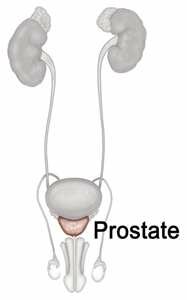The?Prostate Overview
As a younger man, prostate problems are unthought of, because it didn't affect your health. But as men age, some of the cells that make up the prostate may change, causing benign (noncancerous) or malignant (cancerous) tumors to grow. Knowing about your prostate anamotmy can help you understand more about what the prostate does and how it can be treated.
The prostate is a chestnut-shaped reproductive organ located directly beneath the bladder in the male, which adds secretions to the sperm during the ejaculation of semen. The gland surrounds the urethra, the duct that serves for the passage of both urine and semen; rounded at the top, the gland narrows to form a blunt point at the bottom, or apex. The diameter in the broadest area is about 4 cm (1.6 inches). The two ejaculatory ducts, which carry sperm and the fluid secreted by the seminal vesicles, converge and narrow in the centre of the prostate and unite with the urethra; the urethra then continues to the lower segment of the prostate and exits near the apex.
The prostate gland is a conglomerate of 30 to 50 tubular or saclike glands that secrete fluids into the urethra and ejaculatory ducts. The secretory ducts and glands are lined with a moist, folded mucous membrane. The folds permit the tissue to expand while storing fluids. Beneath this layer is connective tissue composed of a thick network of elastic fibres and blood vessels. The tissue that surrounds the secretory ducts and glands is known as interstitial tissue; this contains muscle, elastic fibres, and collagen fibres that give the prostate gland support and firmness. The capsule enclosing the prostate is also of interstitial tissue.
In man, the prostate contributes 15?30 percent of the seminal plasma (or semen) secreted by the male. The fluid from the prostate is clear and slightly acidic. It is composed of several protein-splitting enzymes; fibrolysin, an enzyme that reduces blood and tissue fibres; citric acid and acid phosphatase, which help to increase the acidity; and other constituents, including ions and compounds of sodium, zinc, calcium, and potassium. Normally the prostate reaches its mature size at puberty, between the ages of 10 and 14. Around the age of 50, the size of the prostate and the amount of its secretions commonly decrease. Increase in size after midlife, often making urination difficult, may occur as a result of inflammation or malignancy. Males who do not secrete adequate amounts of the male hormone androgen may maintain normal function of the prostate with injections of androgen (Viagra).
There are different reasons for prostate cancer, prostate enlargement and prostatitis. There are even?some symptoms that?are not easily noticed.?This is why its important?for older men to visit the doctor to have?your?prostate?checked.???
?
?
